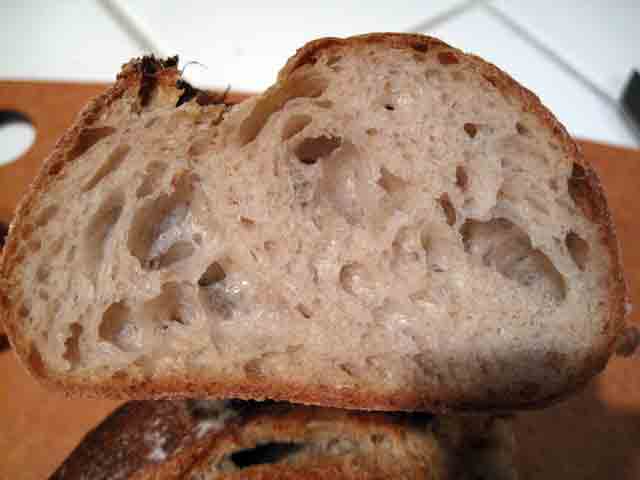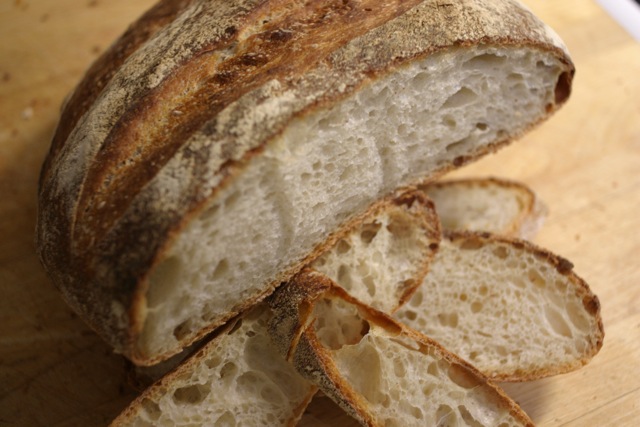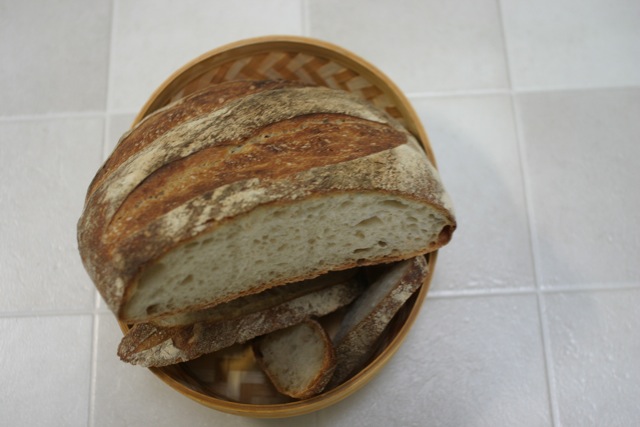Hello. I’m Glenn Snyder. I’ve been a member at TFL for some time, following the baking adventures of my brother, David, and enjoying this web community. But I never baked bread before yesterday. And never posted a blog entry before now.
I have enjoyed bread my whole life. From Karsh’s Bakery (RIP) in Fresno where we grew up, then from various bakeries in the San Francisco Bay Area where I’ve spent most of my life. My favorite breads are sourdoughs made by Semifreddi and Acme in the Bay Area, by Beaujolais Bakery and Fort Bragg Bakery on California’s North Coast and, of course and especially, those made by David [I may occasionally in this forum butter my brother up, but I also may try to get a rise out of him—btw, I don’t like puns as much as he does].
As has been recorded in these pages (http://www.thefreshloaf.com/node/19250/premarital-counseling-advice-my-baby-brother-aspiring-sourdough-baker), I fell upon some sourdough starter that David left in our refrigerator at a family gathering several weeks ago. It was intended for our visiting sister, but she had left town without it. So I took it in, as a stray kitten. I fed it. It seemed to like me. I decided I should try baking with it.
Now, I am already an avid and moderately skilled cook. And I do love to eat good bread. But I had never pursued home baking, except the occasional dessert. I suppose it was partly because it seems so complicated and time-consuming. And I already have enough time-consuming hobbies to fill my free time. But the mewing kitten, and encouragement from my brother and my bread-loving spouse, got me to try it out.
Before I describe my first baking experience, let me explain the reference to “D’Oh! Boy”. I work in a law firm called Pillsbury. Our amateur ballteams have often been called “The Dough Boys”. And I personally love Pillsbury’s biscuits. The “D’Oh” reference, besides being a good pun and showing my general enjoyment of all things Homer Simpson, reflects my Guiding Philosophy in trying new things. We learn from our mistakes. Ergo, the more mistakes we make, the more available lessons from which to learn. So I treasure those “d’Oh!” moments, and thankfully I have many. As this post will illustrate.
Before starting my experiments, I read quite a bit on TFL, and got some very useful advice from David about tools and techniques. I also adopted low expectations so as to increase the likelihood that the results would be pleasing (I am quite skilled at manipulating my own emotions).
First Batch
David suggested I start with a simple San Francisco Sourdough. He suggested Susan’s recipe (http://www.thefreshloaf.com/node/6927/well-i-finally-did-it). In order to maximize my experimental data, I made two double batches of dough this weekend to make four batards. The starter was acting nicely. It had been fed 1:3:4 with David’s recommended flour combo (70% APF/20% WW/10% Rye). The first batch of starter was fed Friday morning and was ready late Friday afternoon, and I mixed the first batch of dough Friday early evening using a dough scraper and bare hands. A very satisfying sensation. I soon realized that the need to follow the dough’s schedule was going to interfere with sleep (not an option for me) unless I manipulated the fermentation time. So, contrary to the recipe I was (not) following, the first batch went into an Igloo cooler with some Blue Ice to ferment slowly for the night. I was hoping it would have doubled by morning but it had only enlarged about 50% (small d’Oh!), so I put it on our kitchen counter and it had doubled by early afternoon.
I stretched and folded per the recipe and had a nice springy ball to work with.

I clove the ball into two halves and tried to shape them into batards. I didn’t do very well shaping (‘nother d’Oh!). I had looked at written instructions on various TFL blog posts, but had not viewed Floyd’s very useful video on batard shaping (http://www.thefreshloaf.com/node/1688) until after making my mistake. They looked like a cross between a batard and a baguette. A baguard, I guess.

But they proofed nicely (I used the poke test…appropriate for a D’Oh! Boy).
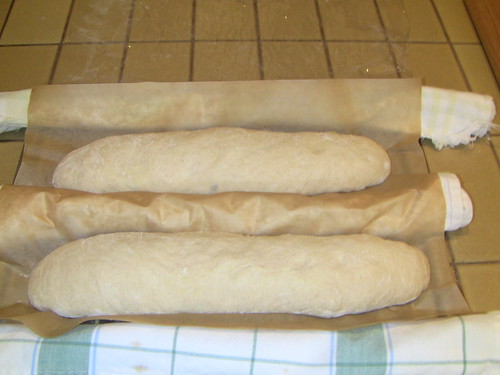 ]
]
And they looked pretty decent after baking on a pizza stone (with steam), except scoring with a paring knife didn’t work well. I need to order a lame.
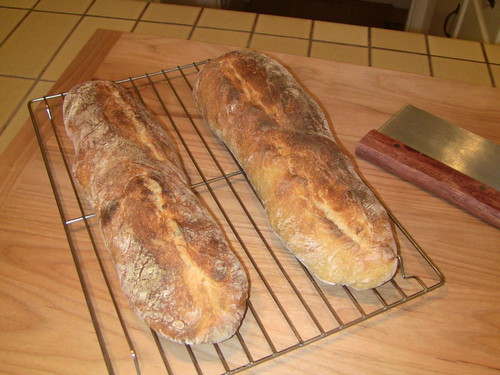

Unfortunately, in my first try at shaping loves I had not sealed the seams well and the bottoms cracked badly. I think this was due to using too much flour on the kneading board, so the dough was not moist enough to cohere at the seams (dry d’Oh!). I also must not have pre-heated my oven enough as the oven spring was only so-so and the bottoms are quite light in color (tepid d’oh!).
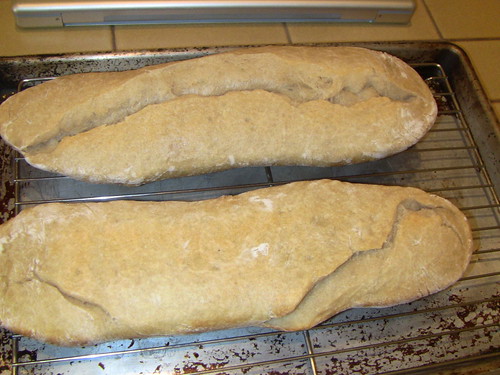
The crumb looks pretty good for a first try. David says it’s either natural talent, a good instructor or beginner’s luck. I say it’s all three.
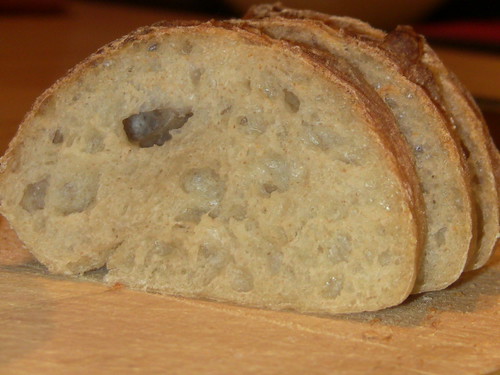
The taste and texture were passable, far exceeding my low expectations, and probably good enough to motivate further trials. The crust was crunchy and not at all tough. The crumb was a bit too moist when first sliced, but is much more satisfactory today—pleasantly chewy, and excellent toasted.
The flavor is complex and enjoyable—sour, yeasty, whole wheaty. I’m not wowed, but I’m not gonna throw the experiment in the trash either. Good bread, not great.
More about my second attempt and the lessons I learned in a later post.
This could get to be habit forming.
Glenn














